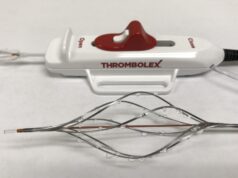
A multisite hospital system analysis of the safety and procedural learning curve behind the performance of percutaneous mechanical thrombectomy for pulmonary embolism (PE) shows significant reductions in both fluoroscopy and procedure times alongside contrast volume over time.
The data, the senior author behind the study says, lend weight to the argument that vascular surgeons need to become more involved in performing this type of procedure in this part of the vasculature.
“Vascular surgeons can do this, we can do it safely, and, with practice, we can do it even better,” explains Jason Chin, a vascular surgeon at Cleveland Clinic Abu Dhabi, the United Arab Emirates, and previously with MedStar Health in Baltimore, USA, where the study was carried out. “And this is a conversation vascular surgeons need to get involved in now or get left behind.”

The MedStar analysis—presented during the 2025 Southern Association for Vascular Surgery (SAVS) annual meeting (22–25 January, St. Thomas, the US Virgin Islands)—involved 420 patients undergoing PE mechanical thrombectomy from January 2020 to July 2024.
In addition to detecting statistically significant falls in fluoroscopy and procedure times and contrast volume, the researchers identified institutional plateaus for improvement of 55 and 138 cases for fluoroscopy time and procedure time, respectively.
Averaged across the number of surgeons participating, it would take an individual surgeon 3.4 cases to become proficient in imaging-related efficiency and 8.6 cases to become proficient in broader procedural efficiency. Additionally, presenting author Perry Diaz, a medical student at Georgetown University School of Medicine in Washington, DC, USA, told SAVS 2025, they found no statistically significant differences between the first and last 50 cases in hospital or intensive care unit (ICU) length of stay or complications. The overall mortality rate was 4.49%.
“Importantly, we also saw that, with the first 50 cases and the last 50 cases out of the 400 we did, we still had good results for both, which I think says good things about being able to start a programme, and still do it safely,” Chin details in an interview with Venous News. “But I think that as we gather more data, within our system and among PE interventionalists at large, we’ll certainly see that improvement in ICU and hospital length of stay, and in some of these outcomes that we saw trends in.”
Navigating the heart is not an area in which vascular surgeons are traditionally trained but the data—which represent different types of practice settings and operators—illustrate they can perform the PE procedure safely and with good results in this part of the vasculature, Chin says. “Certainly, putting a 24F sheath through multiple chambers of the heart can be a little bit nerve racking the first time you do it,” he says, “but when I look at vascular surgeons compared to other interventionalists, in our field we work with these wires, these sized devices, at least as much if not more than any of those other fields.
“Maybe we haven’t always crossed the right atrium and the right ventricle with them, but I think our skillset and the natural anxiety we might have about some of the complications we might have to deal with from related procedures, it does make us safe in that section of the vasculature, and it’s a natural extension of a lot of the deep venous work we do.”
Chin also drew reference to the scale of venous disease circulating among the population at large. “Venous thromboembolic disease—and venous disease in general—is at least as common, if not a lot more common than arterial disease. And maybe it isn’t as limb or necessarily life threatening compared to arterial disease, but it’s still out there and still affects a lot of people,” he adds.









